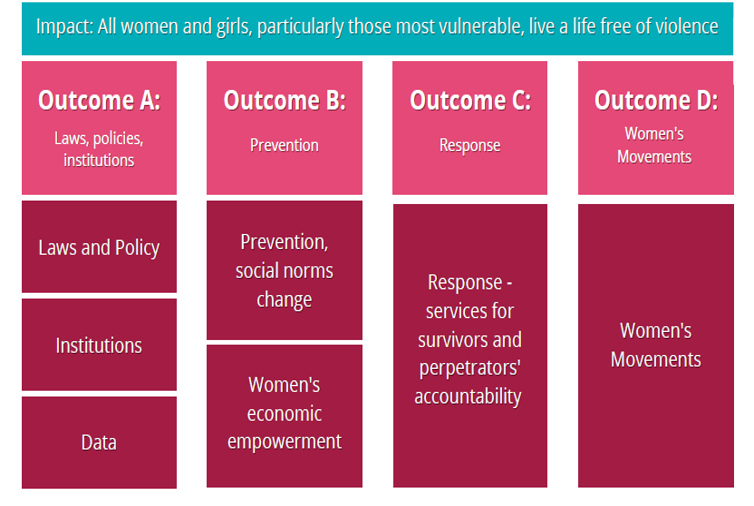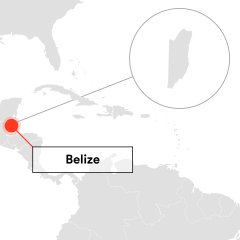Get started with M&E

Get started with M&E
Case Studies

Spotlight Initiative’s overarching goal in its Theory of Change (ToC) is to ensure that all women, especially those who are marginalised and vulnerable, live free from violence and harmful practices. Together with its partners, Spotlight Initiative aims to make concrete changes in six Outcome Areas or Pillars to end VAWG. Changes in these six Outcome Areas contribute to achieving SDG 5 and SDG 16. ToC “if/then” logic statements were then crafted for each Outcome to describe the desired results.

Example: IF/THEN TOC for Outcome 1 (Legislative and policy frameworks)
IF
(1) Women and VAWG/Harmful Practices experts are engaged in assessing, developing and implementing policies and legislation to address VAWG/HP; and
(2) Relevant decision-makers and stakeholders in all sectors of government are informed, mobilised and trained to address VAWG/HP; and
(3) adequate budgets are allocated; and
(4) the capacity of national institutions to collect disaggregated VAWG/HP data in line with globally agreed standards is strengthened
THEN
(5) an enabling legislative and policy environment is in place and institutions can develop, coordinate and implement programmes that integrate the elimination of VAWG/HP and other SDG targets into development planning processes
BECAUSE
(6) institutional change requires effectively implemented legislative and policy frameworks, appropriate capacity, adequate funding as well as political engagement and leadership to sustainably address VAWG/HP.
Country level results frameworks then capture high-level results under the Initiative’s Outcome Areas, with impact indicators adjusted at regional levels, but then feeding into reporting on a global level in the Annual Reports.
Example indicators:
An example outcome indicator for outcome 1 is: "Laws and policies on VAWG/HP in place that adequately respond to the rights of all women and girls, including exercise/access to SRHR, and are in line with international HR standards and treaty bodies’ recommendation".
A corresponding output is "National and regional partners have strengthened evidence-based knowledge and capacities to assess gaps and draft new and/or strengthen existing legislations on ending VAWG and/or gender equality and non-discrimination that respond to the rights of most groups facing multiple and intersecting forms of discrimination and are in line with international HR standards and treaty bodies’ recommendations".
An example output indicator is "Number of draft new and/or strengthened laws and/or policies on ending VAWG and/or gender equality and non-discrimination developed that respond to the rights of women and girls facing intersecting and multiple forms of discrimination and are in line with international HR standards, within the last year".



At the global level, Spotlight Initiative consolidates country-level information received into a central result-based management system called the SMART platform. This monitoring and reporting tool gathers performance data at the outcome and output levels, linking programme-related result indicators so evaluators can better measure the efficiency and effectiveness of Spotlight Initiative. Result indicators are specific to each country or regional programme. For outcomes, shared indicators are defined in the overall and regional result frameworks.
Programme stakeholders are obligated to report against selected outcome indicators. Recipient United Nations organisations (RUNOs) are responsible for gathering data - a mandatory element reflected in every Spotlight Initiative annual report. The SMART platform contributes to a more integrated way of reporting by United Nations agencies, strengthens quality assurance and facilitates the consolidation, aggregation and visualisation of results (data reported and infographics in Spotlight Initiative’s global annual reports are produced directly using SMART).
Additionally, external evaluations are required to assess the performance of each programme, and are conducted mid-term and at the time of programme closure. Evaluations are used to analyse programme performance, and test the global and regional theories of change of the Initiative. Mid-term and final independent evaluations assess the overall performance of the Initiative, inclusive of its design, management, and overall performance against global objectives.
For example, the mid-term assessments for all Spotlight Initiative country programmes, from November 2020-April 2021 for Latin America and Africa and October 2021-April 2022 for the Caribbean and Asia-Pacific, provided valuable insights to strengthen interventions and select a way forward for programmes. They also helped foster stronger collaboration and commitment to collective action across stakeholders (government, civil society, the European Union and United Nations teams). These assessments follow a results-oriented monitoring methodology and provide an analysis of programmes’ relevance, efficiency, effectiveness and sustainability. They assessed the performance of each programme and this improved programme management by informing stakeholders about the performance of the interventions and identifying lessons to test Spotlight Initiative’s Theory of Change.
Finally, the assessments provided critical information to guide the Operational Steering Committee’s decisions on additional budget allocations for Phase II. These reports highlighted the efficient and nimble adaptation of programmes to issues surrounding COVID-19 restrictions, including ensuring that services for survivors of violence are seen as essential and seeking new ways to reach communities during COVID-19 restrictions.



Participatory monitoring ensures a needs-driven approach that adapts as new needs arise, enabling programmes to help identify appropriate interventions to meet the specific needs of survivors and civil society organisations.
Spotlight Initiative in Belize embraced a collaborative approach with civil society partners throughout the programming cycle, including in monitoring and reporting processes. Through community-based dialogues with implementing partners and beneficiaries, stakeholder consultations, and programmatic visits, the voices of civil society partners were meaningfully reflected in programming. This has promoted shared learning and improved co-ownership of the programme.
To ingrain this promising practice in the Initiative’s strategy, the team created an M&E framework that embeds participatory monitoring & evaluation (ensuring this approach is not simply adopted ad hoc, but rather institutionally grounded, carried out systematically and sustainably over time).







